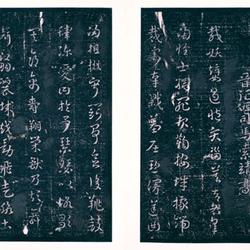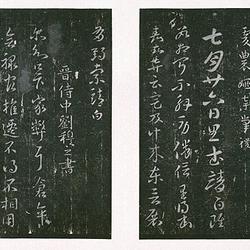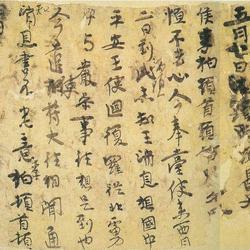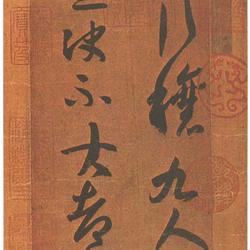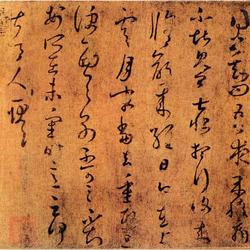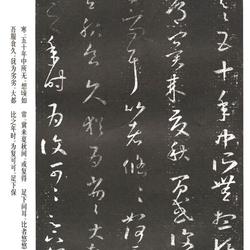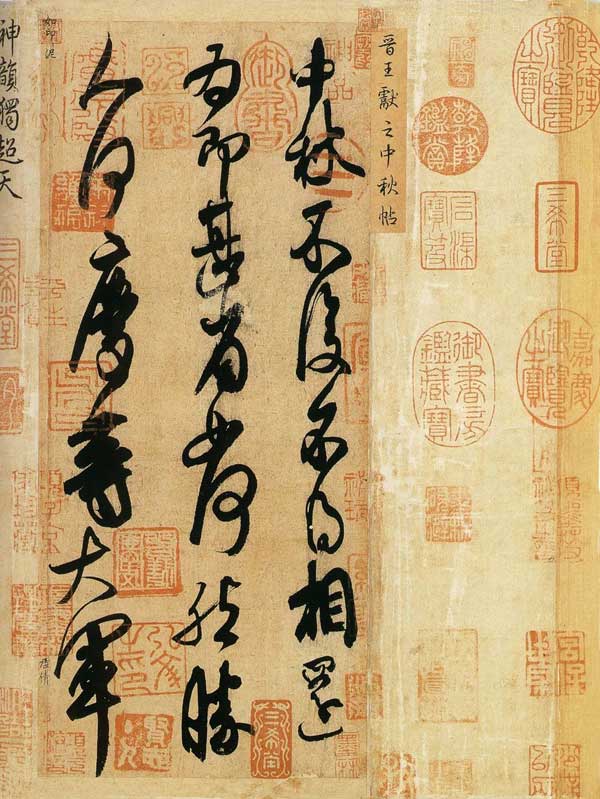
"Mid-Autumn Tie" is said to be a book presented by the King of Jin Dynasty, paper, hand scroll, 27cm in length and 11.9cm in width.
"Mid-Autumn Tie" is a famous ancient calligraphy work. It was once praised as one of the "Three Treasures" by Gaozong Hongli (Emperor Qianlong) of the Qing Dynasty, which means a rare treasure.
3 lines of running script, 22 words in total, explanation:
The Mid-Autumn Festival will no longer miss each other
It's even more economical
He is better than He Qing
Waiting for the army
No signature.
"Mid-Autumn Tie" is said to have been written by Wang Xianzhi, and together with Wang Xizhi's "Kuai Xue Shi Qing Tie" and Wang Xun's "Bo Yuan Tie" are collectively known as "Three Hopes", they are now in the collection of the Palace Museum. "Shu Duan" says: "The style of the characters is made up of one stroke. Occasionally there are discontinuities, but the veins are continuous. If they are connected, the climate is consistent with the interlaced lines." The calligraphy of "Mid-Autumn Tie" is bold and bold, which should be a new style created by Wang Xianzhi. "Mid-Autumn Tie" is an incomplete copy of "Baojin Zhai Fa Tie" and "December Cut Tie". The original post contains the six words "December Cut to No" before "Mid-Autumn Festival". The post was written on bamboo paper. This kind of paper was not available in the Eastern Jin Dynasty and did not appear until the Northern Song Dynasty. It can be seen from the writing brushes that the brushes used are soft and unintentional brushes, while the Jin Dynasty used hard-intentional brushes, which have poor water absorption. The lifting, pressing and turning of the brush are often not flexible and free, and there are often hairs, so the brush is so plump. It is impossible to write the effect of being round and mature, having coherent lines, flowing Qi, and being free and elegant. Wu Sheng's "Da Guan Lu" of the Qing Dynasty says: "The calligraphy of this calligraphy is ancient and thick, and the black color is fresh and smooth, but it is as big as a fat maidservant. Although it is not hooked and filled in, it is probably imitated by people in the Song Dynasty." According to the research of contemporary calligraphy and painting connoisseurs, most of them are believed to be from the Song Dynasty. It was copied by the painter Mi Fu, so it is equally valuable.
The front of the volume is preceded by the two characters "Zhibao" written in running script by Hongli, Emperor Gaozong of the Qing Dynasty.
Across the water in front is a section inscribed by Emperor Qianlong.
On the upper right side of the post text is the line "Mid-Autumn Festival Posted by the King of Jin" inscribed by Emperor Qianlong.
At the back of the volume are inscriptions and postscripts by Dong Qichang and Xiang Yuanbian of the Ming Dynasty and Qianlong of the Qing Dynasty, including a section each of paintings by Emperor Qianlong and Ding Guanpeng.
On the front and back of the volume and across the water are seals from the "Xuanhe" Neifu of Beijing in the Song Dynasty, the Neifu of the Southern Song Dynasty, Xiang Yuanbian, Wu Ting of the Ming Dynasty, and the Neifu of the Qing Dynasty.
This post was collected by the Xuanhe and Shaoxing Neifu of the Song Dynasty, Xiang Yuanbian of the Ming Dynasty, and the Neifu of the Qing Dynasty. During the Republic of China, Puyi took him out of the palace and dispersed among the people. Before the founding of the People's Republic of China, it was pawned to a foreign bank in Hong Kong together with Wang Xun's Boyuan Tie. At the end of 1951, when the pawn period was about to expire, someone abroad tried to buy it. After hearing the news, Premier Zhou Enlai immediately instructed the relevant departments to buy it back and put it in the Palace Museum.
"Xuanhe Shupu" of the Song Dynasty, Zhang Chou of the Ming Dynasty, "Qinghe Painting and Calligraphy Boat", "Qinghe Knowledge Table", "Qinghe Secret Box Table", Wang Diyu's "Coral Net Book Postscript", Qing Gu Fu's "A Spectacular Life", Bian Yongyu's " It is recorded in Shigutang Calligraphy and Painting Collection, Wu Sheng's Daguan Lu, and Neifu's Shiqu Baoji·First Chapter.

